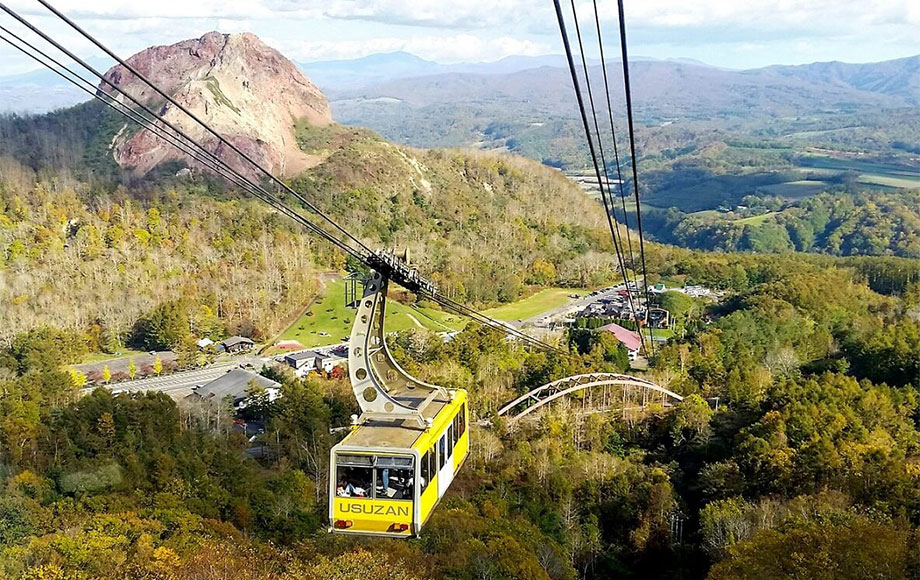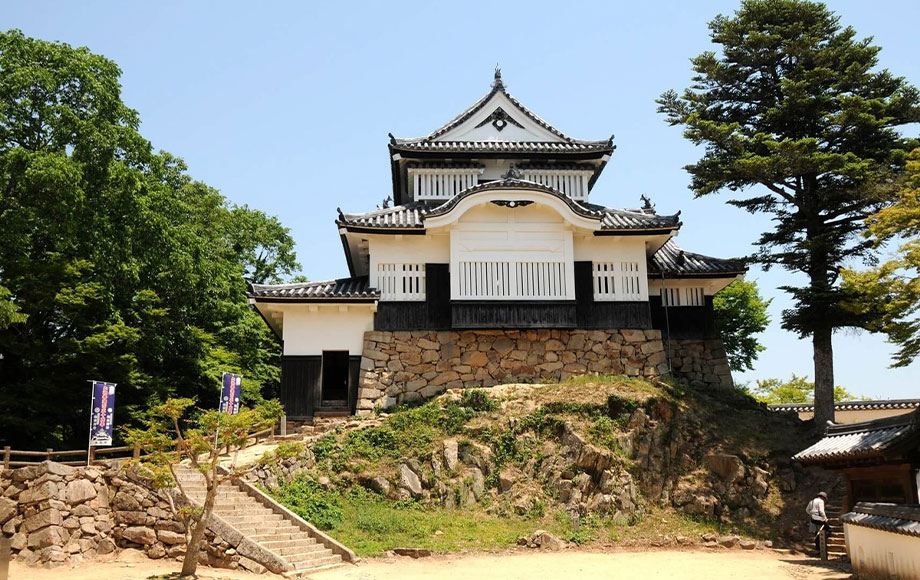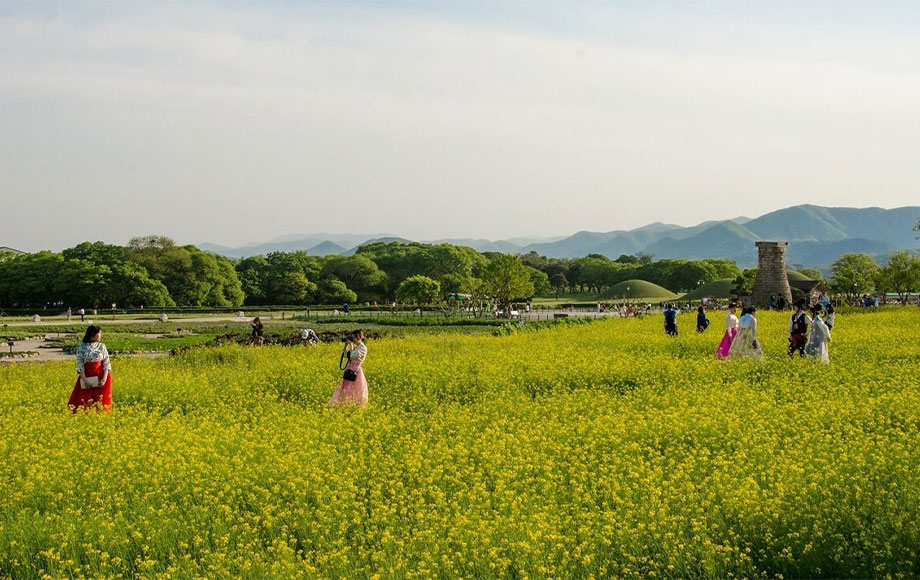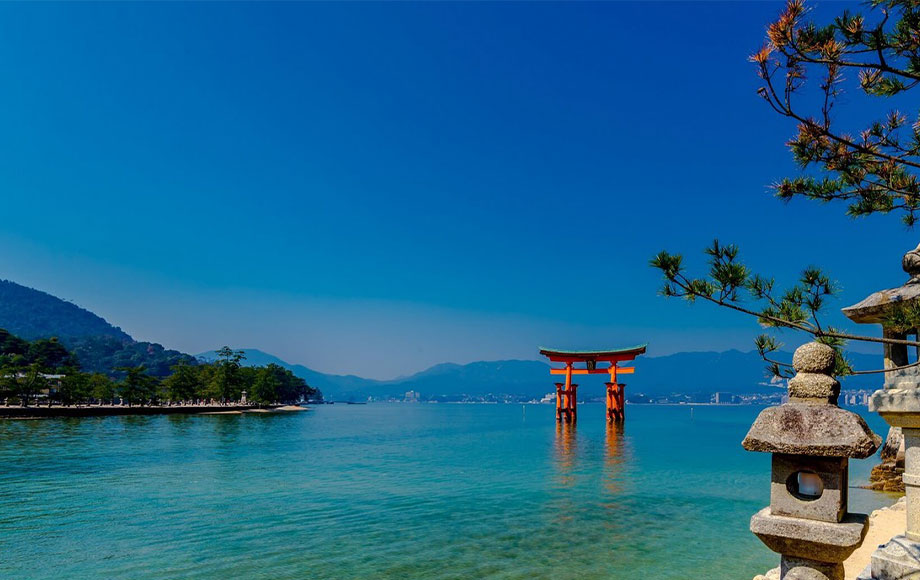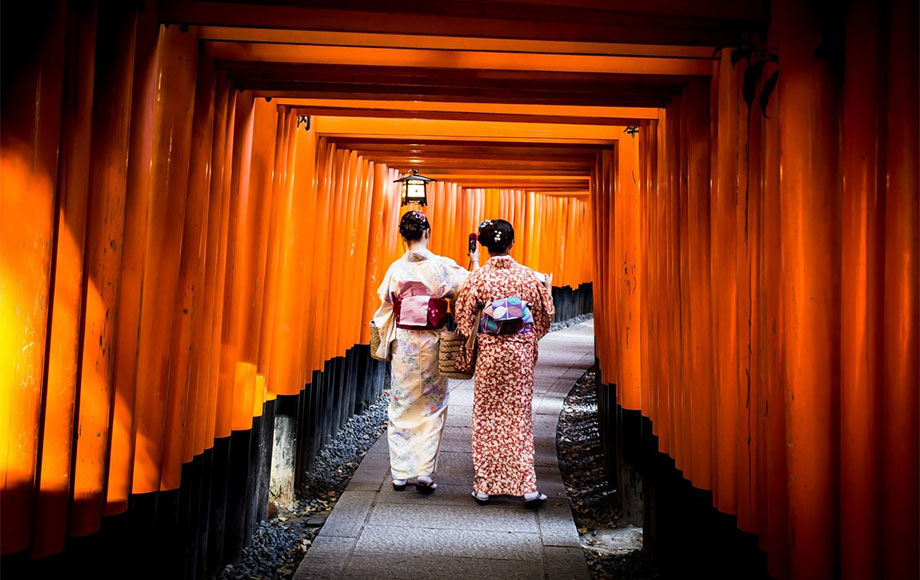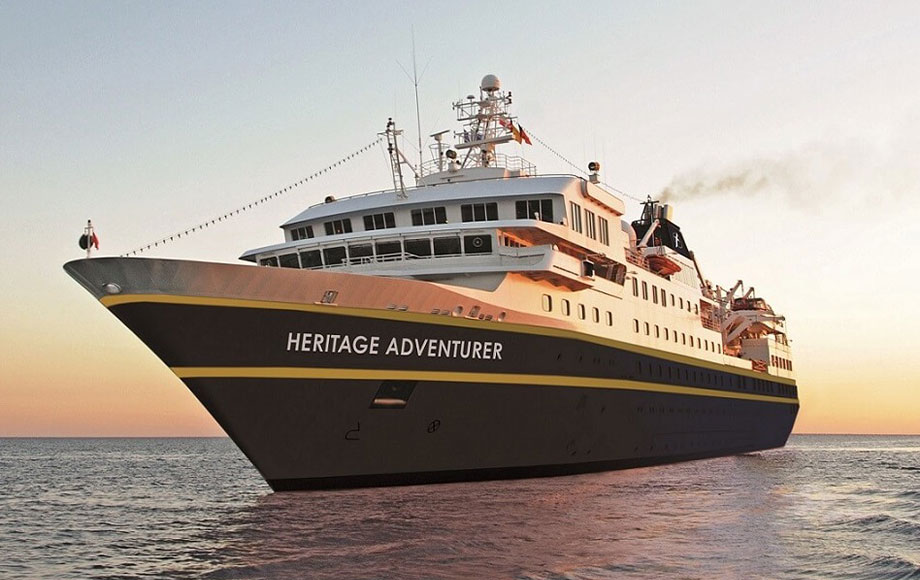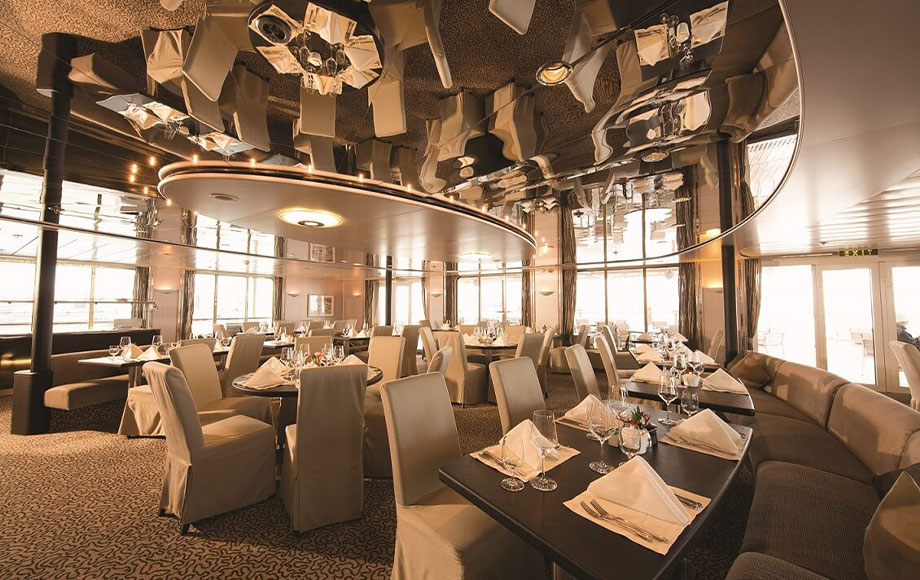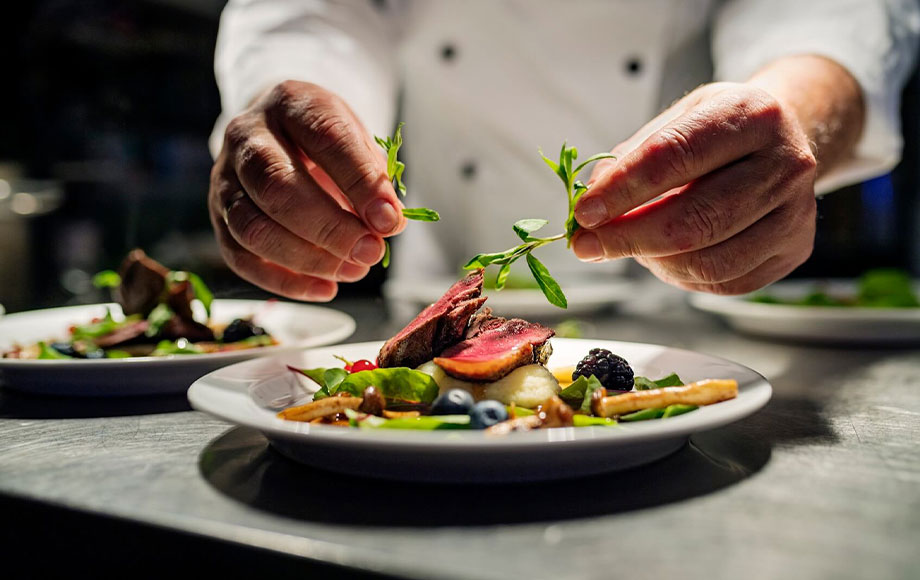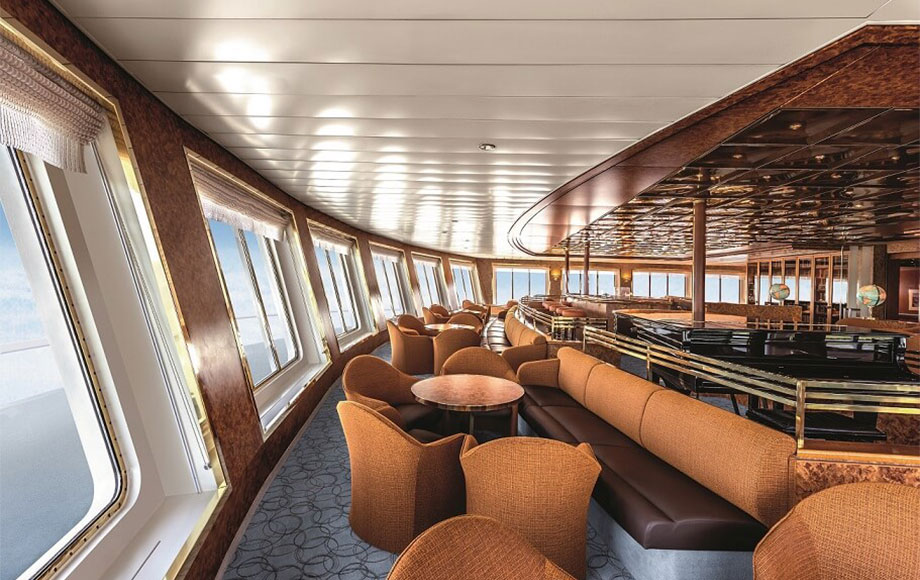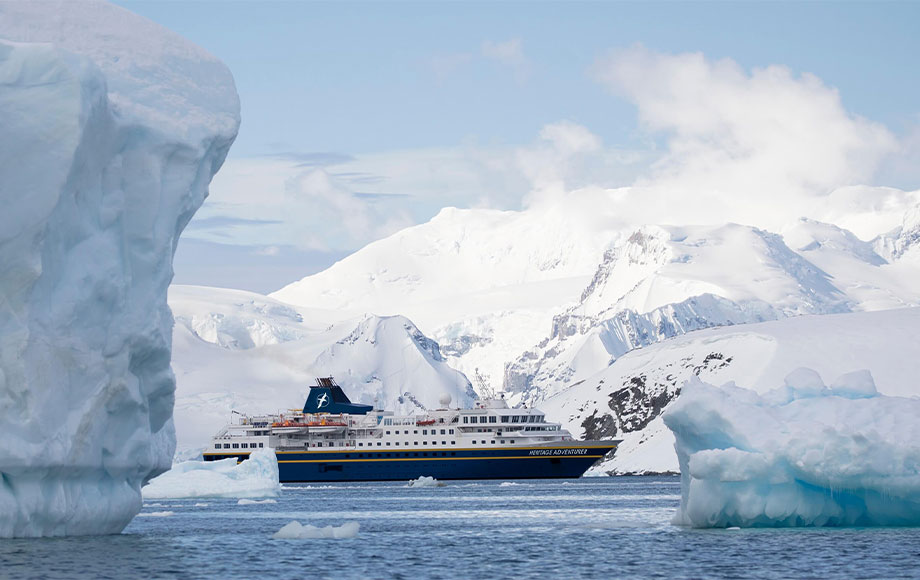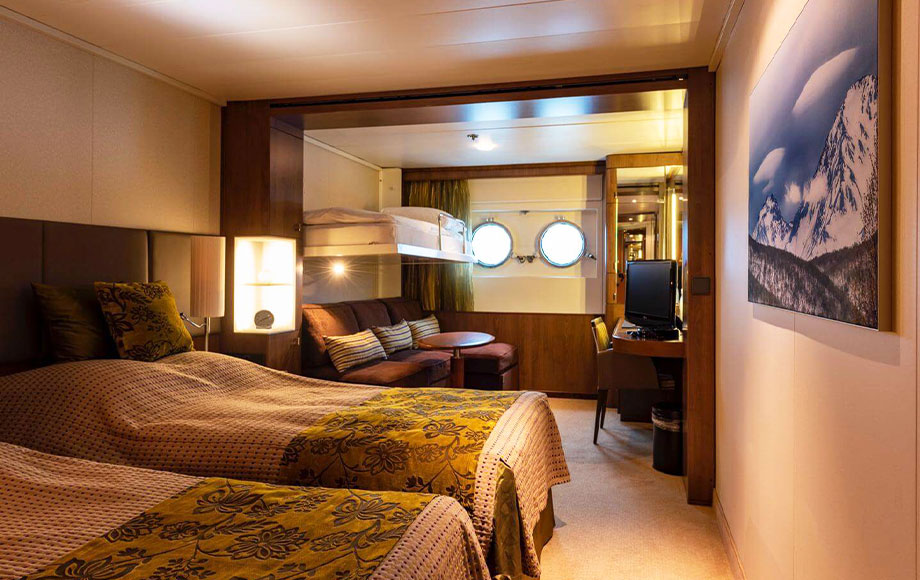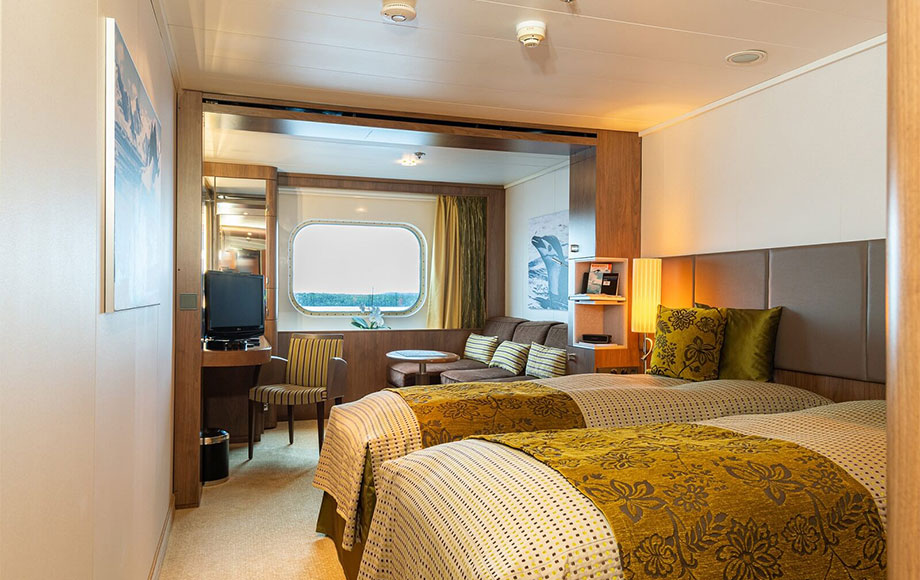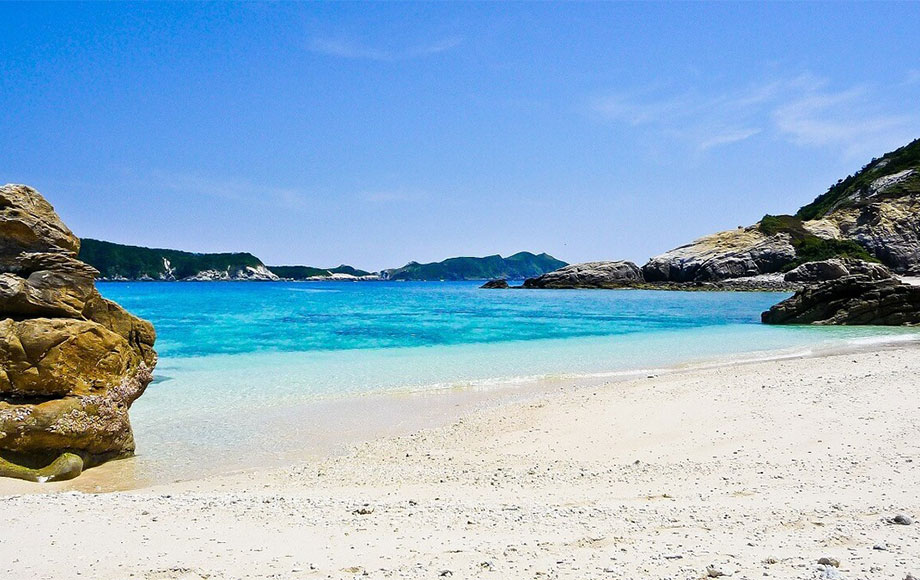Explore Japan ‘the Land of the Rising Sun’, on this adventurous 15 day itinerary from Otaru to Kobe, including a day in the South Korean city of Ulsan.
This exciting adventure reveals the beauty, history and incredible culture of Japan, exploring medieval castles and temples, magical gardens, beautiful landscapes, and learning about fascinating cultural history. Not only will travellers visit well-known hot spots, but this cruise takes guests beyond, to remote stretches of coastline and islands tourists rarely have the opportunity to experience.
A country rich in history and tradition, Japan seamlessly blends ancient customs with ultra-modern living and the bright lights of fascinating cities. There are a plethora of amazing highlights on this 15-day adventure, including the five-storey Pagoda of Miyajima, the 17th century Matsue Castle and the sobering Hiroshima Peace Memorial Park with its eternal Flame of Peace.
For art lovers, there is also the opportunity to explore traditional art through visiting galleries and meeting local artists, as well as learning about Japanese paper making in the town of Matsue. Enjoy a day in the South Korean city of Ulsan, where you will visit the fascinating UNESCO World Heritage Site Gyeongju – the ‘museum without walls’ among other highlights. Meanwhile, in Uwajima, one of Japan’s premier pearl producers, there will be the chance to visit one of the city’s traditional pearl farms.
To round of this ultimate itinerary of Japan, there will be a chance to venture into several national parklands, observe wildlife and experience the swathes of colourful flowers in bloom. Other highlights might include the famed flower farms of Hokkaido, Kinashi – one of Japan’s leading bonsai centres, and perhaps the rarely visited Japanese microcosm of Sado Island.
Tour details
- One night pre-cruise hotel accommodation (inc. dinner/breakfast)
- All on board ship accommodation with meals
- House beer, wine and soft drinks with lunch and dinner
- Pre/post cruise transfer
- All expedition shore excursions and activities.
- Programme of lectures by noted naturalists
- Landing fees
- All items of a personal nature
- Laundry, drinks (other than mentioned)
- Gratuities
- International/domestic flights
- Visas and travel insurance
- Visit several beautiful castles including 17th century Matsue Castle
- Wander through Hiroshima’s Peace Memorial Park and harrowing museum
- Explore several of Japan’s beautiful national parks
- Discover some of Japan’s lesser visited sites, and breathtaking islands
- Marvel at Rurikoji Temple, built in 1442, it is considered one of Japan’s top three temples
- Spend a day in the South Korean city of Ulsan
- Enjoy a visit to the UNESCO listed site Gyeongiu – the ‘museum without walls’
Otaru is a port city on the island of Hokkaido, not too far from Sapporo, Hokkaido’s major city and Japan’s 5th largest overall. It is serviced by New Chitose Airport, about 30 minutes from Sapporo’s city centre. There are no direct flights from any Australian cities, but carriers that fly there from Australia include Cathay Pacific via Hong Kong, and budget airline Scoot, via Singapore. Other major airlines that fly into New Chitose Airport include
Otaru is easily reached by train from New Chitose Airport. There is a direct service that runs between New Chitose Airport Station and Otaru Station. The journey takes 1 hour and 15 minutes.
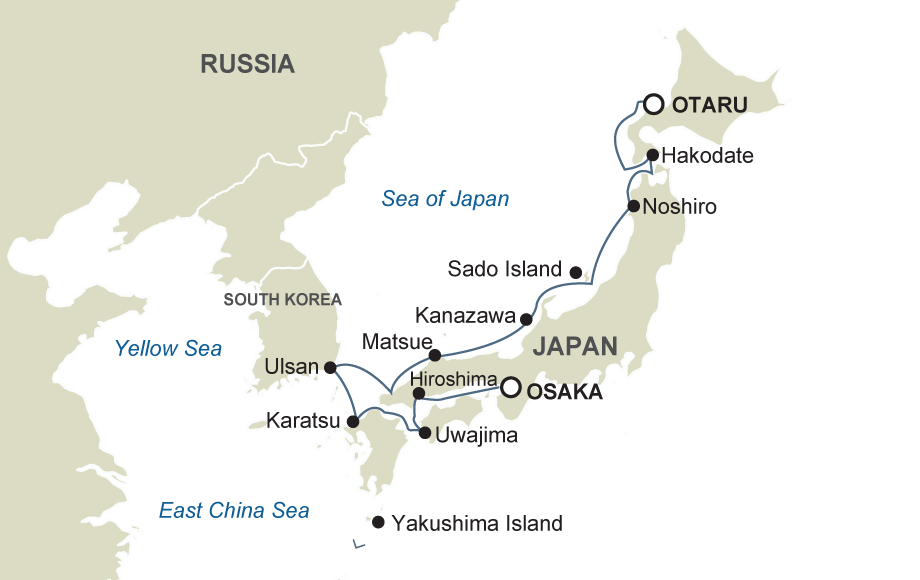
Itinerary
Discover Eternal Japan
15 days/14 nights
Day 1
Otaru
Arrive today in Otaru, a port city in Hokkaido known for glassworks, music boxes, sake distilleries and the picturesque Otaru Canal flanked with shops and cafes built within its repurposed 1920s warehouses. Transfer to your hotel where your group will spend the first night of the expedition. This evening meet your fellow voyagers and expedition team over dinner at the hotel.
Day 2
Otaru
Enjoy breakfast at the hotel before exploring this unique city. This afternoon board your ship, settle into your cabin and familiarise yourself with the vessel. There will also be the opportunity to introduce yourself to the expedition team and learn about the voyage plans.
Day 3
Hakodate
Today, sail into the port of Hakodate, located at the southern tip of Hokkaido. This morning will see you venturing to Onuma Park where the plan is to explore its picturesque, island-dotted lakes and majestic dormant volcano, Mount Komagatake. Explore the lakes’ fascinating and Instagram-worthy peninsulas and islands, many of which are connected by small foot bridges. This afternoon, there will be an option to enjoy a city tour including the enchanting star-shaped Fort Goryokaku. This massive citadel was built in the last years of the Edo Period, but repurposed now as a quirky public park boasting more than 1,000 cherry trees along its moats.
Day 4
Noshiro
Famous for its local beef, pork and chicken and rice soup known as Kiritanpo, tranquil Noshiro is a modern city flanked by nature with the Yoneshiro River winding through its heart. The city is the gateway to the iconic Juniko (12 Lakes) park, this national treasure is actually a collection of 33 crystal-clear ponds and lakes formed by an earthquake in 1704 and surrounded by ancient beech forest. Here you will have the option to explore the forested walks that lead to the serene blue holes, including 10-metre deep Aoike (Blue Pond). Other options may include visiting stunning Lake Towada, a 2,000 year old double caldera 400 metres above sea level, and its surrounding forest in TowadaHachimantai National Park and Japan’s largest pine forest, Kaze no Matsubara, where more than 7 million trees were planted to prevent coastal erosion. Known as the ‘Wind of Matsubara’, in 1996 it was designated as one of the 100 Soundscapes of Japan.
Day 5
Sado Island
Today the plan is to explore remote Sado Island off the coast of Niigata. Comprising the mountain ranges of Osado and Kosado flanking the Kokunaka Plain, the island was once a destination of political exile. It now boasts its own rich cultural and religious life incorporating puppet theatre, Okesa folk songs, Ondeko drumming and demon dances, and Noh theatre thanks to some of its more famous displaced figures. Home to the Japanese Crested Ibis, extinct on the mainland, and the iconic taraibune tub boats, this island off the beaten path combines stunning natural scenery including Senkakuwan Bay and Ogi Peninsula, wilderness and wildlife with a rich history including gold and silver mining, and Samurai warrior culture. Sado Island is widely considered a perfect, miniature version of Japan.
Day 6
Kanazawa
Today spend the day exploring the rich art centre of Kanazawa discovering some of the unique styles of Japanese art. Kanazawa is rightly famous for its Kutani-style pottery, exquisite lacquerware, gold-leaf workmanship, hand painted silk, and classical Noh dance-drama performed since the 14th century. Wander winding cobblestone streets, elegant restaurants, craft galleries and visit the impressive Edo-period Kenrokuen Garden, one of the Three Great Gardens of Japan, and explore the Omicho Market boasting everything from flowers, to crafts and food.
Day 7
Matsue
Set sail towards the port of Sakaiminato and the entry point to Matsue, known as ‘the town of water’ due to being situated between Lake Shinji and Lake Nakaumi. A highlight of your visit will be the Matsue Castle, a national treasure and one of Japan’s few largely intact 17th century castles. Other options today may include exploring Daisen-Oki National Park, steeped in beauty and history it’s also the home of rare flora and fauna including the giant salamander, visiting the picturesque Yuushien Garden, the Adachi Museum of Art, learning about the art of Japanese paper making at the Yakumo-mura village, or perhaps you may wish to spend some time exploring the picturesque streets and local canals.
Day 8
Hagi
Relax on board as the vessel sails south to Hagi, originally a minor fishing port, it is now famously known for its traditional pottery making, which you will have a chance to learn about. You will also have the opportunity to discover the Teramachi District with its temples and shrines, including the famed ‘Ninja Temple’, the Jokomachi District with its old Samurai houses, Hagi Castle ruins at Shizuki Park, and beautiful Zen Tokoji Temple.
Day 9
Ulsan, South Korea
Today, cross the Sea of Japan to Ulsan in South Korea where the plan is to visit the UNESCO World Heritage Site of Gyeongju. The capital of the Shilla Dynasty and dating back to the first millennium, Gyeongju is known as ’the museum without walls’ and is full of ancient Korean history and Buddhist culture. Enjoy strolling through hundreds of excavated monuments, temples, tombs and pagodas and enjoy Korean delicacies, cultural performances, and visit the National Museum with its gold jewellery, metal weapons, and distinctive pottery. Today provides a perfect taste of South Korea.
Day 10
Karatsu
Once a major stop for ships and a trading post between Korea and China, Karatsu is well known for its medieval heritage including the Karatsu Castle. Built on a plain, construction began in 1602 and the castle is also known as the ‘flying crane castle’ as its shape resembles a bird in flight. Tour the castle including the Exhibition Hall, which houses the floats and artefacts used in the annual Karatsu Kunchi autumn festival. If you have an interest in plants and/or pottery, an alternative option for today is a visit to the city of Imari celebrated for its porcelain pottery kilns and the flower-laden Mifuneyama Rakuen garden.
Day 11
Ube
Anchored in the historic port city of Ube, today you will be exploring the Yamaguchi prefecture, the last point on the main island of Honshu. Options here include visiting the Hofu Tenmangu Shrine, believed to be the oldest Tenmangu in Japan having being built in 903, and dedicated to the god of learning. Alternatively, visit the five-storied Pagoda, symbol of Yamaguchi and national treasure Rurikoji Temple. Built in 1442, this Buddhist temple is considered one of Japan’s top three temples and set amidst the beautifully manicured Kozan Park. Take the opportunity to visit the museum which houses thousands of national treasures and explore the beautiful gardens.
Day 12
Uwajima
Today sees you exploring the city of Uwajima, on Japan’s Shikoku Island. One of country’s premier pearl producers, you will have the chance to learn about the traditional process of cultivating and harvesting pearls during a visit to a pearl farm. You may also visit the Uwajima Castle, built in the Edo Period (1603 – 1867), it features spectacular panoramic views of the town, harbour, and the tranquil Tenshaen Garden built in the Samurai era. There will also be some free time today to explore the town or perhaps visit one of the many gardens including Tenshaen and the island’s largest Nanrakuen Gardens. Other options include a meander along a cherry treelined lane in Yoshida, or visiting the historic Kabuki theatre.
Days 13
Hiroshima & Miyajima Island
Despite its history, which includes being the site of the world’s first atomic bomb attack on 6 August 1945, Hiroshima is a vibrant and thriving cosmopolitan community. The plan is to visit the beautiful Peace Park and Museum, with its sombre cenotaph containing names of atomic bomb victims, and the permanently lit ‘Flame of Peace’. After visiting the Peace Park you will travel to Miyajima Island, considered one of Japan’s most scenic spots and the location of the Torii Gate and the Daisho-in Buddhist temple. For those after a nature fix, ascend Mount Misen on Miyajima Island by cable car and enjoy a hike, admiring the views below of the Shinto Shrine and Torri Gate.
Day 14
Takamatsu
Your next stop on Shikoku Island will be Takamatsu. Takamatsu has had a long history as a port town earning itself the nickname ‘Gateway to Shikoku’, although more recently locals have been calling it ‘Udon Kingdom’. If you have an interest in plants, a visit to Ritsurin Park, considered one of Japan’s finest gardens, is sure to be a highlight. Next you will enjoy a visit to Kinashi, one of Japan’s main bonsai production centres, where you will learn about traditional methods of growing bonsai. For those interested in history and art you may wish to travel to Naoshima Island for a full-day excursion. Shikoku Island is known for its art and this excursion to Naoshima will have you admiring its architecture and art museums, including Chichu Art Museum and Benesse House, featuring work by Japanese and international artists.
Day 15
Kobe, Tour ends
This morning sail into Kobe, Japan’s seventh-largest city and third largest port. Considered one of Japan’s most beautiful cities, Kobe was rocked by the Great Hanshin-Awaji Earthquake of 1995 which killed more than 5,000 people and destroyed thousands of buildings. Today the city is completely rebuilt, though a few signs of the terrible event remain. After breakfast there will be a complimentary coach to a central hotel or to Osaka airport, where your tour ends.
Please note: To allow time for disembarkation procedures and travel from Osaka, it is not recommended to book flights departing before 1300 hours.
Heritage Adventurer
Built in 1991 for Polar expedition travel, the Heritage Adventurer (formerly the MS Hanseatic) holds the highest passenger-ship ice-class rating (1A Super). Originally designed to accommodate 184 guests, this world-class polar pioneer now welcomes just 140 passengers, creating a more spacious, comfortable and personalised onboard experience. Facilities include superb indoor and outdoor viewing locations including the Observation Lounge (with 270-degree views), a library, pool, gym, hot tub and steam room. Guests can relax in their comfortable cabins that span 4 decks or meet up with fellow guests in the café or bar. Accompanying each voyage is a world-renowned team of naturalists, botanists, historians and experts as well as a fleet of 14 Zodiacs. The vessel also has an Open Bridge Policy.
- Classification: Lloyds 1AS, GL E4
- Year built: 1991
- Accommodation: 140 guests
- Shipyard: Rauma, Finland
- Engines: 3,940 horsepower (x2)
- Maximum speed: 15 knots
- Cruising speed: 12 knots
- Range: 8,600 nautical miles
- Gross Tonnage: 8,378gt
- Length: 124 metres
- Zodiacs: 14
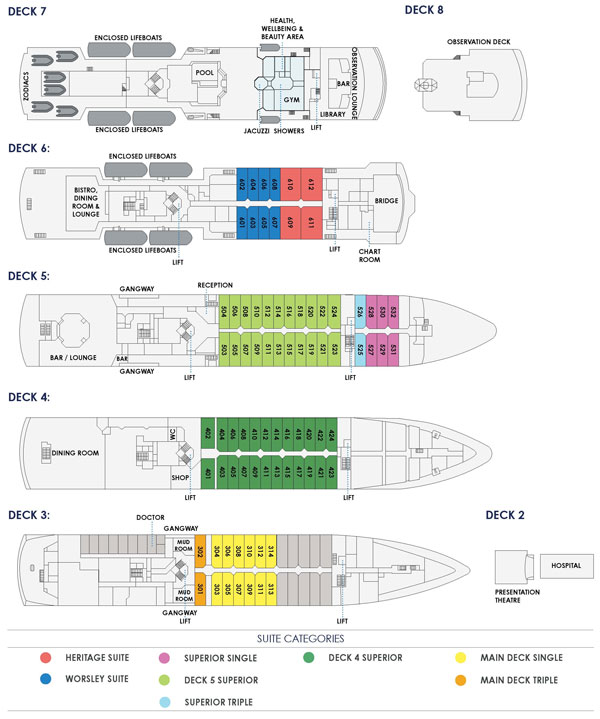
More Japan Itineraries
Subscribe below
Sign up to receive updates about exciting journeys, special offers and more.
